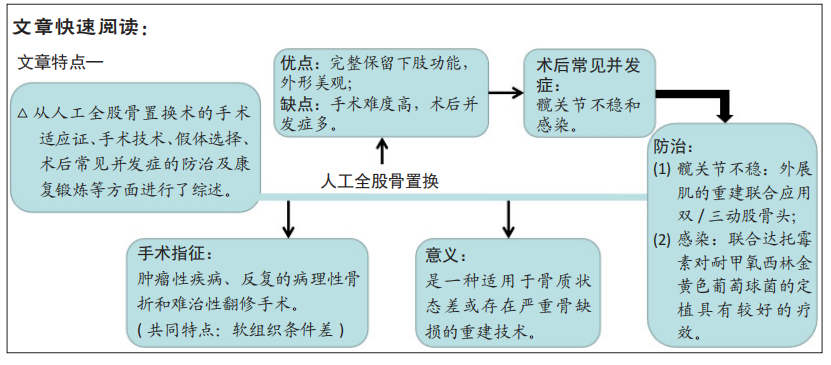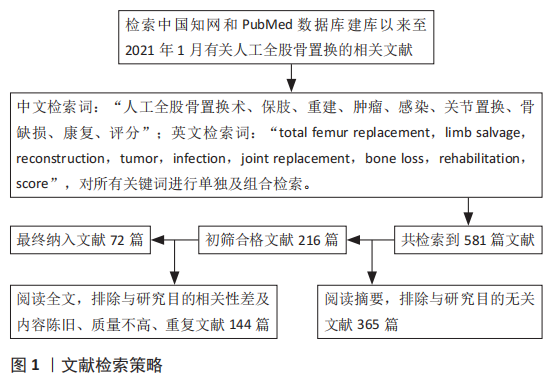[1] 卢新昌,李甲振,张岩,等.股骨干原发恶性肿瘤保肢手术中的重建策略[J].中华骨科杂志,2020,40(18):1282-1290.
[2] 吴凡,方向,郎志刚,等.全股骨置换的研究进展[J].中国修复重建外科杂志,2018,32(10):1346-1350.
[3] KAKIMOTO T, MATSUMINE A, ASANUMA K, et al. The clinical outcomes of total femur prosthesis in patients with musculoskeletal tumors. Sicot J. 2019;5:23.
[4] 冯德宏,王凌,丁育健,等.股骨中心型软骨肉瘤根切定制全股骨假体置换保肢术随访七年一例报告[J].中国骨与关节杂志,2018, 7(11):83-85.
[5] DEROGATIS MJ, ISSACK PS. Total femoral replacement as a salvage operation for the treatment of massive femoral bone loss during revision total hip arthroplasty. JBJS Rev. 2018;6(5):e9.
[6] PUTMAN S, MIGAUD H, SARAGAGLIA D, et al. Total femur replacement in non-oncologic indications: Functional and radiological outcomes from a French survey with a mean 6 years’ follow-up. Orthop Traumatol Surg Res. 2019;105(4):591-598.
[7] BUCHMAN J. Total femur and knee joint replacement with a vitallium endoprosthesis. Bull Hosp Joint Dis. 1965;26:21-34.
[8] BETTIN CC, WEINLEIN JC, TOY PC, et al. Distal femoral replacement for acute distal femoral fractures in elderly patients. J Orthop Trauma. 2016;30(9):503-509.
[9] LIU T, ZHANG X, ZHANG Q, et al. Total femoral reconstruction with custom prosthesis for osteosarcoma. World J Surg Oncol. 2016;14:93.
[10] RICE OM, SPRINGER BD, KARUNAKAR MA. Acute distal femoral replacement for fractures about the knee in the elderly. Orthop Clin North Am. 2020;51(1):27-36.
[11] SANZ-RUIZ P, VILLANUEVA-MARTINEZ M, CALVO-HARO JA, et al. Total femur arthroplasty for revision hip failure in osteogenesis imperfecta: limits of biology. Arthroplast Today. 2017;3(3):154-159.
[12] 邓必勇,邱冰,邓必强.影响骨肉瘤生存率的多因素回归分析[J].安徽医药,2016,20(6):1127-1130.
[13] RAMANATHAN D, SIQUEIRA MB, KLIKA AK, et al. Current concepts in total femoral replacement. World J Orthop. 2015;6(11):919-26.
[14] PAN K, CHAN W, SHANMUGAM P, et al. Large volume osteosarcomas of the femur treated with total femoral replacement. Malays Orthop J. 2014;8(1):32-36.
[15] ZHENG K, YU XC, XU SF, et al. Total femur replacement for treatment of chondrosarcoma involving the entire femur. Orthop Surg. 2015; 7(3):286-287.
[16] EL-GAZZAR A, HÖGLER W. Mechanisms of bone fragility: from osteogenesis imperfecta to secondary osteoporosis. Int J Mol Sci. 2021;22(2):625.
[17] FUKUI K, KANEUJI A, YONEZAWA K, et al. Catastrophic failure of cup revision hip arthroplasty due to undiagnosed Paget disease of bone: a case report. Int J Surg Case Rep. 2020;76:5-10.
[18] APPELMAN-DIJKSTRA NM, PAPAPOULOS SE. Paget’s disease of bone. Best Pract Res Clin Endocrinol Metab. 2018;32(5):657-668.
[19] 彭慧明,翁习生.人工髋,膝关节置换应用的原则与策略[J].骨科临床与研究杂志,2019;v4(6):6-9.
[20] 王坤正,田润,杨佩.对中国关节置换外科未来发展的几点思考[J].中华创伤骨科杂志,2020,22(7):553-555.
[21] ROZELL JC, DELAGRAMMATICAS DE, SCHWARZKOPF R. Interprosthetic femoral fractures: management challenges. Orthop Res Rev. 2019;11: 119-128.
[22] FABRICIO MF, JORDO MT, MIOTTO DS, et al. Standardization of a new non-invasive device for assessment of arterial stiffness in rats: correlation with age-related arteries’ structure. MethodsX. 2020;7: 100901.
[23] ASHWORTH A, KLEIN AA. Cell salvage as part of a blood conservation strategy in anaesthesia. Br J Anaesth. 2010;105(4):401-416.
[24] SAPPEY-MARINIER E, VISTE A, BLANGERO Y, et al. A comparative study about the incidence of dislocation and peri-prosthetic fracture between dual mobility versus standard cups after primary total hip arthroplasty. Int Orthop. 2019;43(12):2691-2695.
[25] GORTER J, PLOEGMAKERS JJW, TEN HAVE B, et al. The push-through total femoral prosthesis offers a functional alternative to total femoral replacement: a case series. Int Orthop. 2017;41(11):2237-2244.
[26] SEVELDA F, SCHUH R, HOFSTAETTER J G, et al. Total femur replacement after tumor resection: limb salvage usually achieved but complications and failures are common. Clin Orthop Relat Res. 2015;473(6):2079-2087.
[27] HOELL S, BUTSCHEK S, GOSHEGER G, et al. Intramedullary and total femur replacement in revision arthroplasty as a last limb-saving option: is there any benefit from the less invasive intramedullary replacement? J Bone Joint Surg Br. 2011;93(11):1545-1549.
[28] NAKAYAMA T, MATSUMOTO S, SHIMOJI T, et al. The significance of rectus femoris for the favorable functional outcome after total femur replacement. Plast Reconstr Surg Glob Open. 2016;4(3):e630.
[29] ARAÇ S, BOYA H. A novel hybrid type (custom-made plus off-the-shelf) total femoral PROSTALAC. Hip Int. 2016;26(4):409-412.
[30] PETERS CL, HICKMAN JM, ERICKSON J, et al. Intramedullary total femoral replacement for salvage of the compromised femur associated with hip and knee arthroplasty. J Arthroplasty. 2006;21(1):53-58.
[31] AMANATULLAH DF, TROUSDALE RT, HANSSEN AD, et al. Non-oncologic total femoral arthroplasty: retrospective review. J Arthroplasty. 2014; 29(10):2013-2015.
[32] FRIESECKE C, PLUTAT J, BLOCK A. Revision arthroplasty with use of a total femur prosthesis. J Bone Joint Surg Am. 2005;87(12):2693-2701.
[33] GRAULICH T, STEIMER D, ZHANG D, et al. High complication and revision rates after total femoral replacement: a retrospective single center analysis of indication, function, and complication. Arch Orthop Trauma Surg. 2019;139(7):913-920.
[34] CARENDER CN, BEDARD NA, MALVITZ TA, et al. Salvage of distal femoral replacement loosening with massive osteolysis using impaction grafting: a report of 2 cases. JBJS Case Connect. 2020;10(3):e2000183.
[35] MAUPIN JJ, CORNING E, STEINMETZ RG, et al. Creating a dual articulating antibiotic spacer for management of an infected total femur prosthesis hemiarthroplasty. Arthroplast Today. 2019;5(4): 482-485.
[36] MCLEAN AL, PATTON JT, MORAN M. Femoral replacement for salvage of periprosthetic fracture around a total hip replacement. Injury. 2012;43(7):1166-1169.
[37] SARRAZIN J, DARTUS J, MARTINOT P, et al. Salvage reconstruction of hip ligaments using absorbable material to treat recurrent instability of revision THA without abductor mechanism. Orthop Traumatol Surg Res. 2021;107(1):102783.
[38] TOEPFER A, HARRASSER N, PETZSCHNER I, et al. Short- to long-term follow-up of total femoral replacement in non-oncologic patients. BMC Musculoskelet Disord. 2016;17(1):498.
[39] KOHL S, EVANGELOPOULOS DS, SIEBENROCK KA, et al. Hip abductor defect repair by means of a vastus lateralis muscle shift. J Arthroplasty. 2012;27(4):625-629.
[40] WHITESIDE LA. Surgical technique: Gluteus maximus and tensor fascia lata transfer for primary deficiency of the abductors of the hip. Clin Orthop Relat Res. 2014;472(2):645-653.
[41] HWANG JS, BEEBE KS, PATTERSON FR, et al. Infected total femoral replacements: evaluation of limb loss risk factors. Orthopedics. 2011; 34(11):e736-e740.
[42] CHRIST AB, MENDEZ L, GAUSDEN EB, et al. Outcomes and complications following non-oncologic total femoral replacement. Hip Int. 2020;30(6):725-730.
[43] HINAREJOS P, GUIRRO P, LEAL J, et al. The use of erythromycin and colistin-loaded cement in total knee arthroplasty does not reduce the incidence of infection: a prospective randomized study in 3000 knees. J Bone Joint Surg Am. 2013;95(9):769-774.
[44] KURTZ SM, ONG KL, LAU E, et al. Prosthetic joint infection risk after TKA in the Medicare population. Clin Orthop Relat Res. 2010;468(1):52-56.
[45] LIN T, JIN Q, MO X, et al. Experience with periprosthetic infection after limb salvage surgery for patients with osteosarcoma. J Orthop Surg Res. 2021;16(1):93.
[46] 成昌霞,周学颖,李福玮,等.手术时间对手术切口感染影响的研究[J].中华医院感染学杂志,2016,26(5):1111-1112.
[47] 郑文丽,杨玉妹,狄建忠.关节置换围术期感染影响因素分析[J].中华骨与关节外科杂志,2019,12(3):231-235.
[48] NAMBA RS, INACIO MC, PAXTON EW. Risk factors associated with deep surgical site infections after primary total knee arthroplasty: an analysis of 56,216 knees. J Bone Joint Surg Am. 2013;95(9):775-782.
[49] LUENGO G, LORA-TAMAYO J, PAREDES D, et al. Daptomycin plus fosfomycin as salvage therapy in a difficult-to-treat total femoral replacement infection. J Bone Jt Infect. 2018;3(4):207-211.
[50] 达托霉素临床应用专家意见编写专家组,中国研究型医院学会感染性疾病循证与转化专业委员会.达托霉素临床应用专家意见[J].中国感染控制杂志,2019,18(11):989-1003.
[51] 孙强,王丽环,王伟.达托霉素治疗老年患者革兰阳性菌感染的应用效果及症状改善情况分析[J].中国现代药物应用,2020,14(23): 180-182.
[52] 孙秀颖,高靓,蒋媛.达托霉素治疗复杂皮肤软组织感染有效性及安全性的meta分析[J].中国现代应用药学,2019,36(6):93-98.
[53] DEPPE H, RITSCHL LM, VACHA E, et al. Periodontopathogenic bacteria in prosthetic joint infection: a retrospective analysis of 1,673 patients. Quintessence Int. 2019;50(9):694-703.
[54] JEANS E, HOLLEYMAN R, TATE D, et al. Methicillin sensitive staphylococcus aureus screening and decolonisation in elective hip and knee arthroplasty. J Infect. 2018;77(5):405-409.
[55] SPORER SM, ROGERS T, ABELLA L. Methicillin-resistant and methicillin-sensitive staphylococcus aureus screening and decolonization to reduce surgical site infection in elective total joint arthroplasty. J Arthroplasty. 2016;31(9 Suppl):144-147.
[56] TUBB CC, POLKOWKSI GG, KRAUSE B. Diagnosis and prevention of periprosthetic joint infections. J Am Acad Orthop Surg. 2020;28(8): e340-e348.
[57] DUKAN R, MASCARD E, LANGLAIS T, et al. Long-term outcomes of non-invasive expandable endoprostheses for primary malignant tumors around the knee in skeletally-immature patients. Arch Orthop Trauma Surg. 2021. doi: 10.1007/s00402-020-03712-z.
[58] WODAJO FM. Prevention and treatment of pathologic femur fractures: evidence as of 2019. Instr Course Lect. 2021;70:465-474.
[59] HENDERSON ER, O’CONNOR MI, RUGGIERI P, et al. Classification of failure of limb salvage after reconstructive surgery for bone tumours: a modified system Including biological and expandable reconstructions. Bone Joint J. 2014;96-b(11):1436-1440.
[60] KATRAK P, O’CONNOR B, WOODGATE I. Rehabilitation after total femur replacement: a report of 2 cases. Arch Phys Med Rehabil. 2003;84(7): 1080-1084.
[61] 方汉军,方斌,易春智,等.个体化翻修保肢策略治疗骨肉瘤局部复发1例报道[J].中华骨与关节外科杂志,2019,12(12):998-1002.
[62] 葛立业,李东升,杨玉鹏,等.瘤段完整切除联合人工假体重建保肢术治疗股骨远端骨肉瘤患者的中期随访研究[J].临床研究, 2020,28(3):1-2.
[63] 卢新昌,李甲振,张岩,等.股骨干原发恶性肿瘤保肢手术中的重建策略[J].中华骨科杂志,2020,40(18):1282-1290.
[64] MURATORI F, MONDANELLI N, PRIFTI X, et al. Total femur prosthesis in oncological and not oncological series. Survival and failures. J Orthop. 2020;17:215-220.
[65] NOOH A, ALASEEM A, EPURE LM, et al. Radiographic, functional, and oncologic outcomes of cemented modular proximal femur replacement using the “french paradox” technique. J Arthroplasty. 2020;35(9): 2567-2572.
[66] 魏晨旭,何怡文,王聃,等.组织工程学中骨修复材料的研究热点与进展[J].中国组织工程研究,2020,24(10):1615-1621.
[67] 赵雪林,刘亚涛,李健雄,等.旋转成形术治疗儿童股骨远端骨肉瘤[J].中国修复重建外科杂志,2020,34(10):1215-1220.
[68] MAHMOUD A, ABOUJAIB MF, MEDA MR. Long-term follow-up of patients with rotationplasty. Int J Surg Case Rep. 2021;79:295-298.
[69] 沙漠,康两奇,丁真奇,等.全股骨的重建—BⅢb型旋转成形术的外科技术和临床结果[J].骨科,2019,10(4):273-277.
[70] PUETZLER J, DEVENTER N, GOSHEGER G, et al. Hip transposition procedure due to osteosarcoma metastasis of the ilium in a patient with preexisting rotationplasty leads to satisfactory functional result: a case report. Int J Surg Case Rep. 2020;77:739-742.
[71] HENDERSON ER, KEENEY BJ, HUSSON EG, et al. Nonmechanical revision indications portend repeat limb-salvage failure following total femoral replacement. J Bone Joint Surg Am. 2020;102(17): 1511-1520.
[72] VAISHYA R, THAPA SS, VAISH A. Non-neoplastic indications and outcomes of the proximal and distal femur megaprosthesis: a critical review. Knee Surg Relat Res. 2020;32(1):18.
(责任编辑:WJ,ZN,ZH)
|


